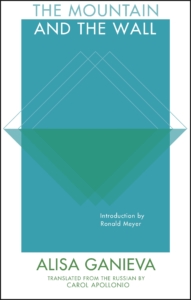Tr. by Carol Apollonio
Alisa Ganieva’s The Mountain and the Wall is the first English translation of a novel from the Republic of Dagestan, a federal subject of Russia in the Caucasus region, neighboring Chechnya. Religiously, it is mostly Muslim but ethnically incredibly diverse, and Ganieva’s novel touches on these distinct cultural histories. The Mountain and the Wall shows culture tied to the past, an old village lifestyle meeting the modern world, in dress, in dating habits, in movies. It portrays the rising tide of Islamism, and the reasons behind it, clashing with Western life, with the Russian state, with the past of Dagestan, and with other Muslims. There is compassion for the damage done to Muslims blasé about their religion or who don’t believe their faith calls for violence and condemnation. Under this is the lingering Soviet history. All of it makes for a complex though clear portrait of a place. It’s a portrait of Dagestan and other regions where Islamism has found a foothold, expressive of the lives disrupted by it. Through fiction and emotional connections to people and community The Mountain and the Wall is about political, social, and religious history and present.
Narratively and stylistically it is a familiar realist novel, grounded in plot, characters, emotions, and dialog, but the landscape, the pace of a day, the traditions, habits, subjects of conversation, offer new perspectives. Of weddings, a woman says:
And in Mugi, picture this, the groom’s mother pours warm oil over her new daughter-in-law so that it stains her clothes. And the Gimrin grooms have to gather enough firewood for the whole winter for their fiancées . . . And in the Laks, if it’s raining and flooding, they’ll catch a frog and dress it in men’s pants to make the rain stop.
Conversation may not be fact, but that people speak such things, have these thoughts and stereotypes, ways of thinking, reveals Dagestan. It is a place first overtaken by Communism, and in the abuses and crumbled vacuum left by that idealogy now threatened by the new fanaticism of Islamism. This opening, this process, is part of what The Mountain and the Wall gives empathy and understanding to, through memories, tales, and raging emotions. Older than any of that is the Dagestan that all the characters love, even if that love is weakening or buried, exhausted.
Ganieva’s great accomplishment here, matched by Apollonio’s translation, is giving voices to an entire community, of friends, family, enemies, lovers, rivals. The main character, Shamil is a local reporter who tends towards the modern, Western, way of life, but plenty of chapters leave him aside and follow other villagers. When he is the spine of a chapter, he is often quiet, only part of a conversation between a whole group of people. There are those who celebrate freedom from Communism, remembering the propaganda, the corruption of the fat party members. Some surrender to Islamism and others fear and loathe it. There are those who see little difference between any fundamentalist ideological rule. Hoped for and lost futures are recounted, and new ones die on the horizon. Philosophies clash and arguments break out, over matters personal, political, or of faith. People interrupt, talk over each other, insult one another. Through Ganieva their voices are passionate, clear. Some families survive the arguments, others fracture; some people change beliefs, others are resolute.
The community is in conversation with itself. We meet new people and they get a name, a dash of characteristics, just so they can speak a few sentences, then maybe not be seen again, or encountered briefly later on. Others are given more attention and time: Makhmud Tagirovich, a poet and writer; Shamil’s ex-fiancée; Shamil’s friend; a cousin, Asya, an energetic, independent young woman he drawn to. Shamil never stays in place, half-investigating the rumors that the Russian government is building a wall to seal off the Caucasus, running into neighbors, friends, relatives, hearing gossip of people’s lives and their relationships, rumors of Islamisists, of fights against them. Rumor and fact blend together, impossible to peel apart. This is a confused world, one with escalating tempers and tensions, where crowds quickly become mobs — where violence, whether in word or deed, can break out in a moment — making it both more important and more difficult to find clarity.
Shamil is Westernized mostly in his listless apathy. He is tired of the arguments, of propaganda and rumors. He doesn’t believe anything has or will change. It’s when his fiancée leaves him for a fundamentalist and becomes one herself that he begins to rise from apathy. His wandering exposes him to his community, to their angers, fears, and desires, to the modern ways and traditional ways. He sees what is at stake. State administrators flee as the intensity of the conflicts increases; mujahideen destroy beauty salons, shops, anything that violations their version of Islam; and the dreams of all these people we’ve met die off at an increasing pace. The past, too, is destroyed: “Today the museum vaults and display cases had been plundered. Today the antique weapons and Kaitag embroidered textiles had been looted, along with the carved wooden boxes and carnelian-jet beads . . . But the greatest loss were the bronze statuettes, cast millennia ago, of bare-breasted, full-buttocked nude female figures, laughing horsemen with dangling legs.” But The Mountain and the Wall provides hope Dagestan is not lost. A literal dream of the land, of the past villagers, departs from reality. In it, Shamil meets older villagers, speaking archaically. This is not a retreat into self, as he shares the dream with his friend, but an expression of love for the land, for those mountains of the title. The land, seen in its beauty and the depths of the past, is the beating heart of Ganieve’s novel. Troubles may not be overcome, but they might be survived, and that love and the resiliency of a community ever malleable is the path to it. The Mountain and the Wall asks us to love and understand Dagestan, and the ask is compelling.
This post may contain affiliate links.








